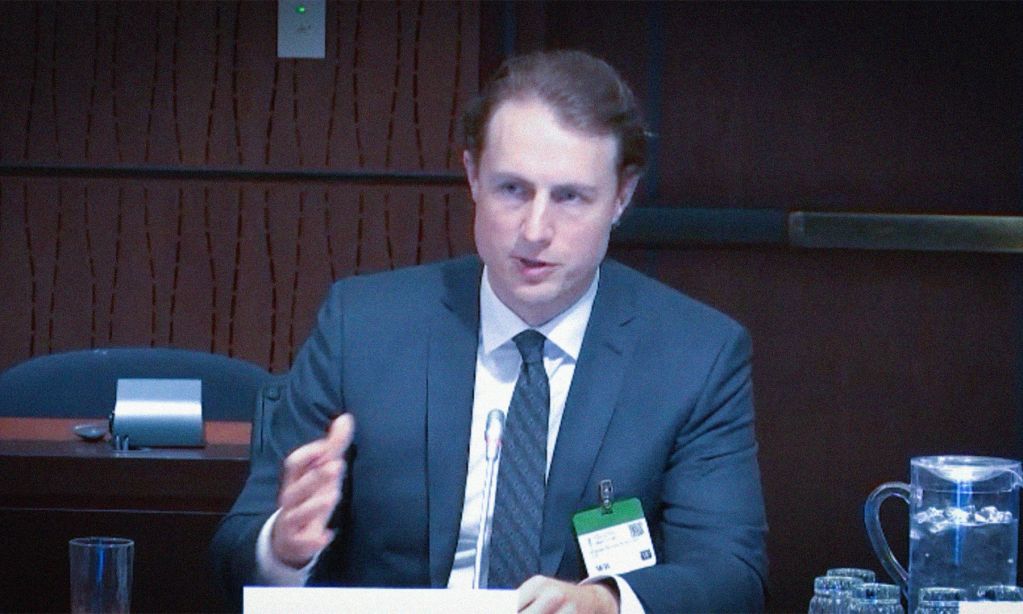Since September, the federal government has been collecting testimony in its pre-budget consultations for the 2024 federal budget. In those consultations, experts and civil society organizations provide recommendations for how the feds should prioritize spending in the next budget.
Hadrian Mertins-Kirkwood, a senior researcher at the Canadian Centre for Policy Alternatives, has written extensively about the ways the federal government can use budgeting and industrial policy to plan a climate transition that puts workers and communities first. This year, he has co-authored reports about federal climate spending and how grassroots movements can advance climate transitions even in the absence of federal leadership.
Mertins-Kirkwood spoke to the Standing Committee on Finance (FINA) on Nov 2, and outlined how the feds could use their next budget to launch a genuine industrial plan for the climate transition. You can read his opening remarks, which have been lightly edited for clarity, in full below.
Thank you to the committee for the invitation to speak about the 2024 federal budget. Every year, the Canadian Centre for Policy Alternatives produces an Alternative Federal Budget in collaboration with dozens of organizations and experts from across the country. Our 2024 edition was released in August and I’m excited to be able to share some of our recommendations with you. In particular, I will focus my remarks on my own areas of expertise, which are climate policy and green industrial policy, but I am happy to address questions about the federal budget more broadly.
For context, green industrial policy is something our biggest allies and competitors are already engaged in. The U.S., the EU, China and others are putting the weight of government behind a cleaner economy—and that means the playing field in growth industries is not level. If we want to compete in a global economy that is moving away from fossil fuels, we need government to play a larger role in the market.
To be clear, this is not optional. The Canada Energy Regulator forecasts an 83 per cent decline in oil sands production in its global net-zero scenario. The International Energy Agency recently forecast a 76 per cent decline in global oil demand under a similar scenario. We need to start planning now for what our post-oil economy will look like in the coming decades, whether we like it or not.
The federal government has started to experiment with green industrial policy. Budget 2023, as you know, included investment tax credits worth tens of billions of dollars. But this approach of trying to incentivize the private sector to do the heavy lifting of transitioning Canada to a cleaner economy has its limits.
First, there’s no guarantee that the market will buy in. That was made very clear by the Canada Infrastructure Bank’s inability to attract private capital under its original mandate. For projects of vital national importance—things like tripling the capacity of our electricity grid, which underpins basically everything else we do on climate—we can’t afford to wait and hope that the private sector steps up.
Second, if the credits turn out to be too generous they will effectively pad the profits of private investors without leading to any actual increase in total green investment. That’s a waste of money that could be better spent on public goods.
Third, and perhaps most importantly, this market-led approach to green investment will not resolve the regional dimensions of the climate transition. Much of the public money that has been allocated to clean industry is going to flow to corporate headquarters in Toronto and Calgary—and not into the often-rural communities that actually need investment in economic diversification.
So, if those are the problems, what are the alternatives?
In the Alternative Federal Budget, we call first of all for a comprehensive national green industrial strategy. This government has published lots of strategies, for critical minerals, emissions reductions and so on, but they do not all share a single, coherent vision for the economy. We cannot be a climate leader that meets our emissions goals while also being an exporter of oil and gas, either practically or morally. We need a whole-of-economy strategy that starts from the end point—an economy free of fossil fuels by 2050—and works backward to what that means for policy today.
When it comes to spending, we call for direct public funding—not financing, not corporate incentives—in a number of key sectors, including $5 billion per year to decarbonize and expand the electricity grid and $15 billion per year for energy efficiency retrofits of homes and buildings. The federal government is already spending in these and other strategic areas, but we simply need more capital given the urgency of the climate crisis.
We call for new, public-interest mandates for both the Canada Infrastructure Bank and the Canada Growth Fund. Instead of trying to de-risk private investment, these institutions should be offering funding and low-cost loans to governments and communities, especially those most affected by the transition to net-zero. In other words, we’d like these institutions to function more like public banks that can support community-led, public interest initiatives.
We also call for $1 billion per year for more aggressive workforce development policies. It’s no secret that we’re already facing large skills shortages in key sectors in the clean economy and that problem is only getting worse. Training or retraining workers for these jobs will not only enable us to build the green economy we want, but it will also help to ease the transition away from fossil fuels for affected workers in an equitable way.
These are just a handful of recommendations from the Alternative Federal Budget. The full document includes hundreds of recommendations across 26 chapters in every area of federal policy, so I strongly encourage you to take a look.
Thank you again for your time and I look forward to your questions.







